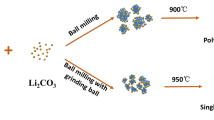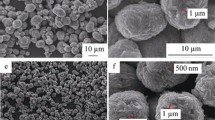Abstract
Effect of secondary particle fracture on the accumulated cycle capacity fade of LiNi1-x-yCoxMnyO2 cathode is difficult to evaluate since performance degradation of electrode material is always caused by several factors simultaneously. Herein, LiNi0.5Co0.2Mn0.3O2 single particles (Sin-P) are prepared and introduced as a reference to understand the accumulated cycle capacity fade caused by the secondary particle fracture of LiNi0.5Co0.2Mn0.3O2 secondary particles (Sec-P). Sec-P exhibited accumulated cycle capacity fade compared to Sin-P when cycled at high rate, high voltage, and high temperature. The accumulated cycle capacity fade was mainly caused by the secondary particle fracture of Sec-P, which was confirmed by the X-ray diffraction (XRD), X-ray photoelectron spectroscopy (XPS), and scanning electron microscope (SEM) analysis. Further, XPS and electrochemical impedance spectroscopy (EIS) analysis indicated that the surface property changes and resistance rise were responsible for the accumulated cycle capacity fade. The study provides a novel way to analyze the accumulated cycle capacity fade caused by the secondary particle fracture and is helpful for understanding the performance degradation mechanism of electrode material.






Similar content being viewed by others
References
Tan S, Wang L, Bian L, Xu J, Ren W, Hu P, Chang A (2015) Highly enhanced low temperature discharge capacity of LiNi1/3Co1/3Mn1/3O2 with lithium boron oxide glass modification. J Power Sources 277:139–146
Nguyen DT, Kang J, Nam KM, Paik Y, Song SW (2016) Understanding interfacial chemistry and stability for performance improvement and fade of high-energy Li-ion battery of LiNi0.5Co0.2Mn0.3O2//silicon-graphite. J Power Sources 303:150–158
Wang G, Xie J, Wu C, Zhang S, Cao G, Zhao X (2014) Submicron lithium nickel manganese oxide spinel with long cycling stability and high rate performance prepared by a facile route. J Power Sources 265:118–124
Lee EJ, Chen Z, Noh HJ, Nam SC, Kang S, Kim DH, Amine K, Sun YK (2014) Development of microstrain in aged lithium transition metal oxides. Nano Lett 14:4873–4880
KY O, Siegel JB, Secondo L, Kim SU, Samad NA, Qin J, Anderson D, Garikipati K, Knobloch A, Epureanu BI, Monroe CW, Stefanopoulou A (2014) Rate dependence of swelling in lithium-ion cells. J Power Sources 267:197–202
Hausbrand R, Cherkashinin G, Ehrenberg H, Gröting M, Albe K, Hess C, Jaegermann W (2015) Fundamental degradation mechanisms of layered oxide Li-ion battery cathode materials: methodology, insights and novel approaches. Mater Sci Eng B 192:3–25
Kleiner K, Dixon D, Jakes P, Melke J, Yavuz M, Roth C, Nikolowski K, Liebau V, Ehrenberg H (2015) Fatigue of LiNi0.8Co0.15Al0.05O2 in commercial Li ion batteries. J Power Sources 273:70–82
Kim Y (2013) Investigation of the gas evolution in lithium ion batteries: effect of free lithium compounds in cathode materials. J Solid State Electrochem 17:1961–1965
Qiu XY, Zhuang QC, Zhang QQ, Cao R, Qiang YH, Ying PZ, Sun SG (2012) Investigation of layered LiNi1/3Co1/3Mn1/3O2 cathode of lithium ion battery by electrochemical impedance spectroscopy. J Electroanal Chem 687:35–44
Zhao K, Pharr M, Hartle L, Vlassak JJ, Suo Z (2012) Fracture and debonding in lithium-ion batteries with electrodes of hollow core-shell nanostructures. J Power Sources 218:6–14
Liu XH, Huang JY (2011) In situ TEM electrochemistry of anode materials in lithium ion batteries. Energy & Environmental Science 4:3844–3860
Mukhopadhyay A, Sheldon BW (2014) Deformation and stress in electrode materials for Li-ion batteries. Prog Mater Sci 63:58–116
Korsunsky AM, Sui T, Song B (2015) Explicit formulae for the internal stress in spherical particles of active material within lithium ion battery cathodes during charging and discharging. Mater Des 69:247–252
Sha O, Qiao Z, Wang S, Tang Z, Wang H, Zhang X, Xu Q (2013) Improvement of cycle stability at elevated temperature and high rate for LiNi0.5-xCuxMn1.5O4 cathode material after Cu substitution. Mater Res Bull 48:1606–1611
Liu W, Wang M, Gao X, Zhang W, Chen J, Zhou H, Zhang X (2012) Improvement of the high-temperature, high-voltage cycling performance of LiNi0.5Co0.2Mn0.3O2 cathode with TiO2 coating. J Alloys Compd 543:181–188
Siegel JB, Stefanopoulou AG, Hagans P, Ding Y, Gorsich D (2013) Expansion of lithium ion pouch cell batteries: observations from neutron imaging. J Electrochem Soc 160:A1031–A1038
Awarke A, Lauer S, Wittler M, Pischinger S (2011) Quantifying the effects of strains on the conductivity and porosity of LiFePO4 based Li-ion composite cathodes using a multi-scale approach. Comput Mater Sci 50:871–879
Watanabe S, Kinoshita M, Nakura K (2014) Capacity fade of LiNi(1-x-y)CoxAlyO2 cathode for lithium-ion batteries during accelerated calendar and cycle life test. I. Comparison analysis between LiNi(1-x-y)CoxAlyO2 and LiCoO2 cathodes in cylindrical lithium-ion cells during long term storage test. J Power Sources 247:412–422
Li J, Downie LE, Ma L, Qiu W, Dahn JR (2015) Study of the failure mechanisms of LiNi0.8Mn0.1Co0.1O2 cathode material for lithium ion batteries. J Electrochem Soc 162:A1401–A1408
Kızıltaş-Yavuz N, Herklotz M, Hashem AM, Abuzeid HM, Schwarz B, Ehrenberg H, Mauger A, Julien CM (2013) Synthesis, structural, magnetic and electrochemical properties of LiNi1/3Mn1/3Co1/3O2 prepared by a sol-gel method using table sugar as chelating agent. Electrochim Acta 113:313–321
Chen G, Song X, Richardson TJ (2006) Electron microscopy study of the LiFePO4 to FePO4 phase transition. Electrochem Solid-State Lett 9:A295–A298
Wang H, Jang YI, Huang B, Sadoway DR, Chiang YM (1999) TEM study of electrochemical cycling-induced damage and disorder in LiCoO2 cathodes for rechargeable lithium batteries. J Electrochem Soc 146:473–480
Wang CM, Xu W, Liu J, Zhang JG, Saraf LV, Arey BW, Choi D, Yang ZG, Xiao J, Thevuthasan S, Baer DR (2011) In situ transmission electron microscopy observation of microstructure and phase evolution in a SnO2 nanowire during lithium intercalation. Nano Lett 11:1874–1880
Liu X, Jia X, Zhang Z, Li Y, Hu M, Zhou Z, Ma HA (2011) Crystal growth and characterization of diamond from carbonyl iron catalyst under high pressure and high temperature conditions. Cryst Growth Des 11:3844–3849
Mukaibo H, Momma T, Shacham-Diamand Y, Osaka T, Kodaira M (2007) In situ stress transition observations of electrodeposited Sn-based anode materials for lithium-ion secondary batteries. Electrochem Solid-State Lett 10:A70–A73
Huang JY, Zhong L, Wang CM, Sullivan JP, Xu W, Zhang LQ, Mao SX, Hudak NS, Liu XH, Subramanian A, Fan H, Qi L, Kushima A, Li J (2010) In situ observation of the electrochemical lithiation of a single SnO2 nanowire electrode. Science 330:1515–1520
Dai Y, Cai L, White RE (2014) Simulation and analysis of stress in a Li-ion battery with a blended LiMn2O4 and LiNi0.8Co0.15Al0.05O2 cathode. J Power Sources 247:365–376
Malavé V, Berger JR, Zhu H, Kee RJ (2014) A computational model of the mechanical behavior within reconstructed LixCoO2 Li-ion battery cathode particles. Electrochim Acta 130:707–717
Ning F, Li S, Xu B, Ouyang C (2014) Strain tuned Li diffusion in LiCoO2 material for Li ion batteries: a first principles study. Solid State Ionics 263:46–48
Cheng YT, Verbrugge MW (2010) Diffusion-induced stress, interfacial charge transfer, and criteria for avoiding crack initiation of electrode particles. J Electrochem Soc 157:A508–A516
Kim H, Kim MG, Jeong HY, Nam H, Cho J (2015) A new coating method for alleviating surface degradation of LiNi0.6Co0.2Mn0.2O2 cathode material: nanoscale surface treatment of primary particles. Nano Lett 15:2111–2119
Bie X, Du F, Wang Y, Zhu K, Ehrenberg H, Nikolowski K, Wang C, Chen G, Wei Y (2013) Relationships between the crystal/interfacial properties and electrochemical performance of LiNi0.33Co0.33Mn0.33O2 in the voltage window of 2.5–4.6 V. Electrochim Acta 97:357–363
Zhang X, Jiang WJ, Mauger A, Qilu GF, Julien CM (2010) Minimization of the cation mixing in Li1+x(NMC)1-xO2 as cathode material. J Power Sources 195:1292–1301
Liao L, Zuo P, Ma Y, Chen X, An Y, Gao Y, Yin G (2012) Effects of temperature on charge/discharge behaviors of LiFePO4 cathode for Li-ion batteries. Electrochim Acta 60:269–273
Liu Z, Kang X, Li C, Hua N, Wumair T, Han Y (2012) Low-temperature behavior of Li3V2(PO4)3/C as cathode material for lithium ion batteries. J Solid State Electrochem 16:1917–1923
Watanabe S, Kinoshita M, Hosokawa T, Morigaki K, Nakura K (2014) Capacity fade of LiAlyNi1-x-yCoxO2 cathode for lithium-ion batteries during accelerated calendar and cycle life tests (surface analysis of LiAlyNi1-x-yCoxO2 cathode after cycle tests in restricted depth of discharge ranges. J Power Sources 258:210–217
Xiao L, Guo Y, Qu D, Deng B, Liu H, Tang D (2013) Influence of particle sizes and morphologies on the electrochemical performances of spinel LiMn2O4 cathode materials. J Power Sources 225:286–292
Acknowledgments
A* Star Singapore-China Joint Research program (No. 2012DFG52130) and Pulead Technology Industry Co. Ltd. are gratefully acknowledged for their financial support for this work.
Author information
Authors and Affiliations
Corresponding authors
Electronic supplementary material
ESM 1
(DOCX 675 kb)
Rights and permissions
About this article
Cite this article
Li, G., Zhang, Z., Huang, Z. et al. Understanding the accumulated cycle capacity fade caused by the secondary particle fracture of LiNi1-x-yCoxMnyO2 cathode for lithium ion batteries. J Solid State Electrochem 21, 673–682 (2017). https://doi.org/10.1007/s10008-016-3399-9
Received:
Revised:
Accepted:
Published:
Issue Date:
DOI: https://doi.org/10.1007/s10008-016-3399-9




